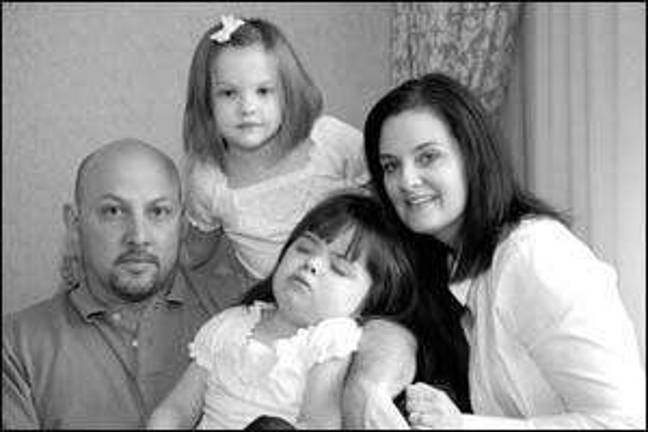Reaching for the cure in Elise's name

Fundraiser for Tay Sachs disease includes clay shoot and auction at Hudson Farms, By Ginny Raue ANDOVER “If love was the cure, Elise would live forever.” So wrote John and Laurie ten Berge in a 2007 Cure Tay-Sachs Foundation newsletter. Sadly, their daughter Elise Catherine, born Feb. 5, 2003, lost her battle with Tay-Sachs disease (TSD) in January of this year. In memory of Elise, to promote awareness of TSD and genetic testing and to raise funds for the Cure Tay-Sachs Foundation, the ten Berges are hosting a Sporting Clay Shoot and Auction at noon on Oct. 8 at Hudson Farms, 270 Stanhope Sparta Road, Andover. Little did this Rockaway couple know when they began dating in high school where their road would lead. Time passed and they were blessed with their first child, Elise. Like all parents they looked forward to seeing her first step, hearing her first word. At birth Elise appeared perfectly healthy. By nine months she was not hitting the usual milestones. “It was her fine motor skills. She wasn’t grabbing the Cheerios, she wasn’t focusing on us with her eyes,” John said. And so began the rounds of doctors and tests. It took six months for a diagnosis. An ophthalmologist discovered red spots on her retinas, indicative of TSD, and the baby was sent to a pediatric neurologist at Columbia University Hospital for further evaluation. “It took him less than 10 minutes. It was a classic case of TSD,” John said. But John and Laurie, being of German, English and Dutch lineage did not fit the classic profile. There is a common misconception that TSD strikes exclusively in the Jewish community. While those of Eastern European Ashkenazi Jewish descent have the highest incidence of TSD, there are other ethnic groups that fall into the high risk category (see side bar). John and Laurie have had genetic testing and accept the fact that they cannot trace the disease through the generations. TSD can be in the family for many years before the illness appears. “We told our parents not to get tested but let’s go in the opposite direction in the family. From here forward, get the blood test,” John said. To complicate matters, Laurie was pregnant when Elise was diagnosed. The one in four chance that the baby would have TSD proved that the odds could be beat for this family and Caroline, born in 2004, does not have TSD. Infantile TSD is a fatal genetic disorder that occurs when two parents each pass the mutated gene to the child. The baby will lack a vital enzyme and harmful quantities of fatty material accumulate in the nerve cells of the brain. Damage to the nervous system ensues, causing deterioration of mental and physical abilities, resulting in death, often by four to five years of age. The initial symptoms usually begin by six months and rapidly progress to seizures, feeding difficulties, loss of motor skills, blindness, deafness, paralysis and loss of mental functions. There is no cure for TSD, nor are there many treatments. Little Elise had a feeding tube, a rescue vest and a machine to push air into her lungs. Over her too-few years of life she was at home, cared for by her parents with the help of a nurse. “We promised her, and ourselves, that we would not leave her in the hospital, hooked up to machines,” John said. They wanted her home, surrounded by love. “Someone was always with her who loved her and gave her millions of kisses a day,” he said. Now John, Laurie and Caroline, who learned early on to care for her sister, are busying themselves by helping other families cope with TSD. While their first local fund raiser is on target they still need items for the auction and monetary donations will be gladly accepted. “Screening is the biggest issue and anything people can do to help push the research so I don’t have to hear about kids passing away - it just shouldn’t be,” John said. To donate auction items call Hudson Farms at 973-398-4330. Monetary donations can be made by visiting www.curetay-sachs.org. Sources: www.curetay-sachs.org; http://en.wikipedia.org; www.ninds.nih.gov/disorders/taysachs/taysachs.htm; http://www.mayoclinic.org; http://www.tay-sachs.org; http://www.albc-usa.org
More about Tay-Sachs
Reported in 2000, due to genetic screening among Jewish population in the United States and Canada, incidence of TSD has decreased significantly.
Orthodox Jewish organization, Dor Yeshorim, conducts screening in Jewish high schools. Students not told results but receive a PIN number and the results can be learned at appropriate time.
Ailing Jacob sheep on a Texas farm found to have the exact form of TSD. Researches believe similarities between sheep, man and TSD are very close. Research goes on for gene therapy cure.
There are about 40 suspected TSD related diseases, including epilepsy, muscular dystrophy and Parkinson’s disease.
About Tay-Sach carriers
Over 1.2 million TSD carriers in the United States and many of them are unaware the disease exists.
Carrier statistics:
1 in 27 Ashkenazi Jews, French Canadians of Southeast Quebec and Southern Louisiana Cajuns
1 in 50 Irish-Americans
1 in 250 in general population
When two carrier parents have a child, three outcomes are possible:
1 - both parents do not pass gene, child is normal
2 - one parent passes the gene, child will be a carrier
3 - both parents pass on the gene, child will have TSD
Three types of TSD
Infantile TSD - onset 3-6 months, death by 3-5 years
Juvenile TSD - rare, onset 2-10 years, death by age 15
Adult late onset - early 20s to 30s, milder form of disease